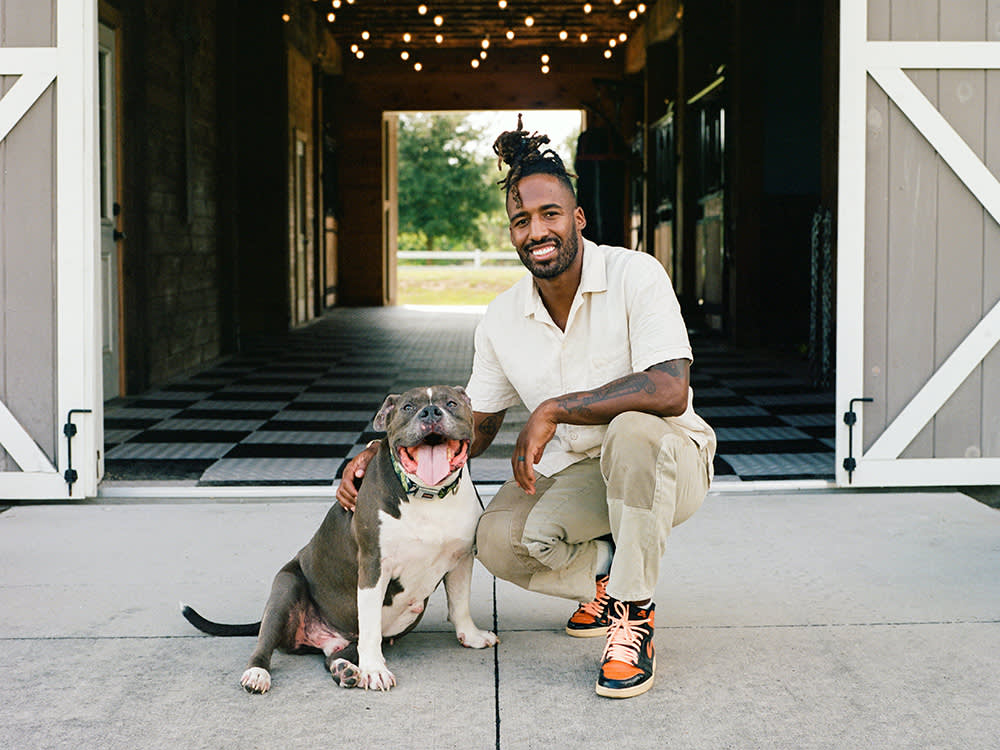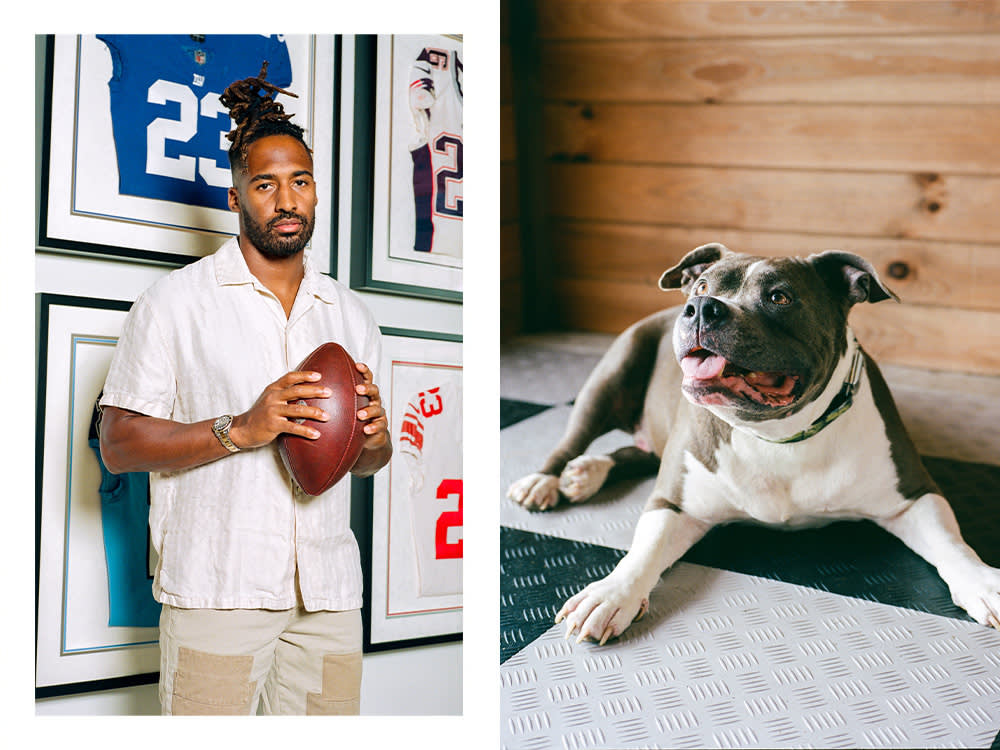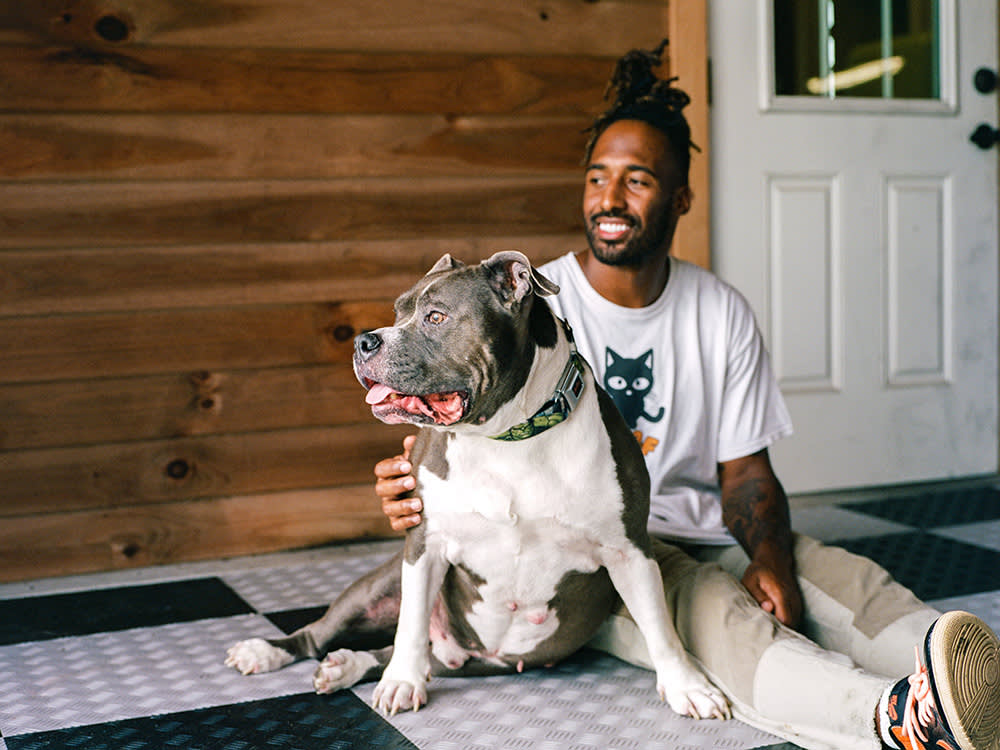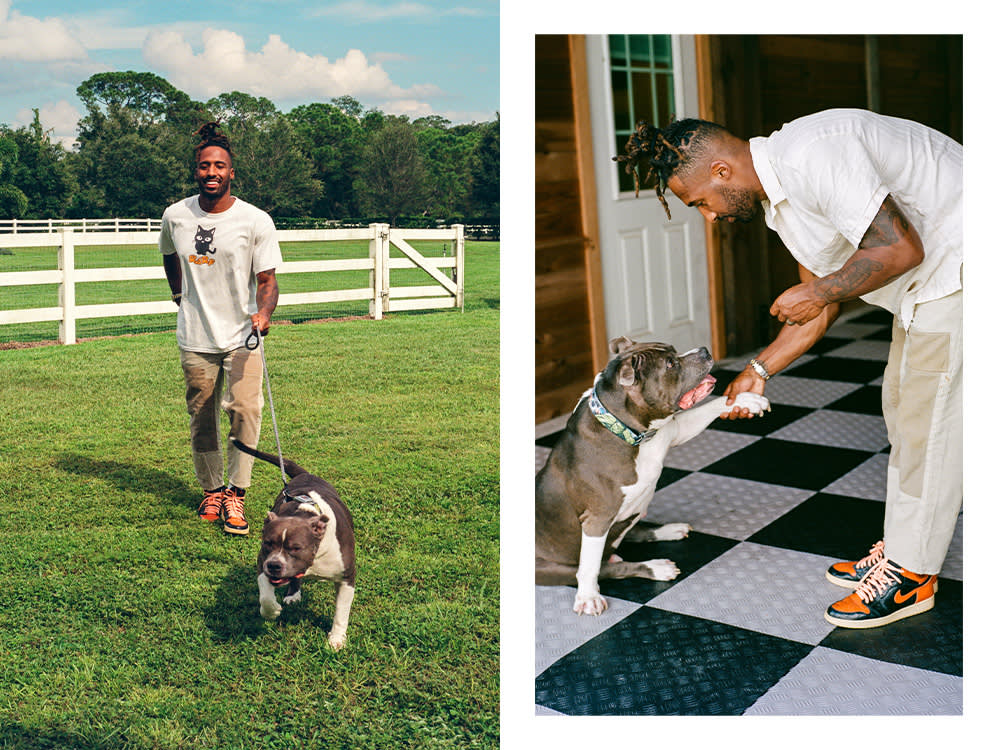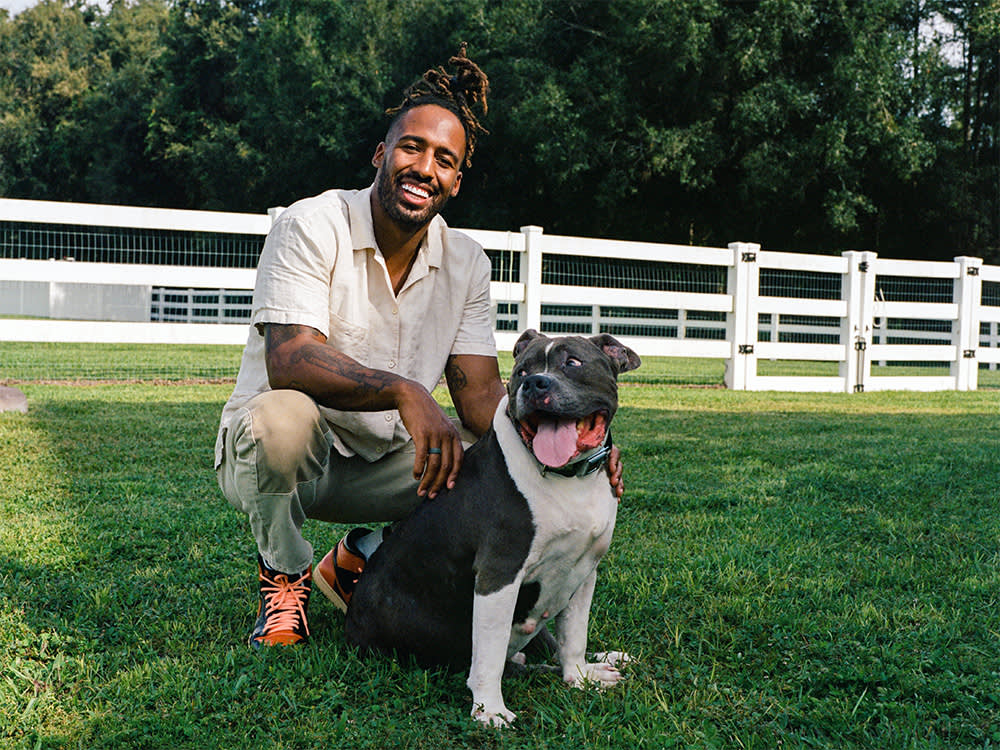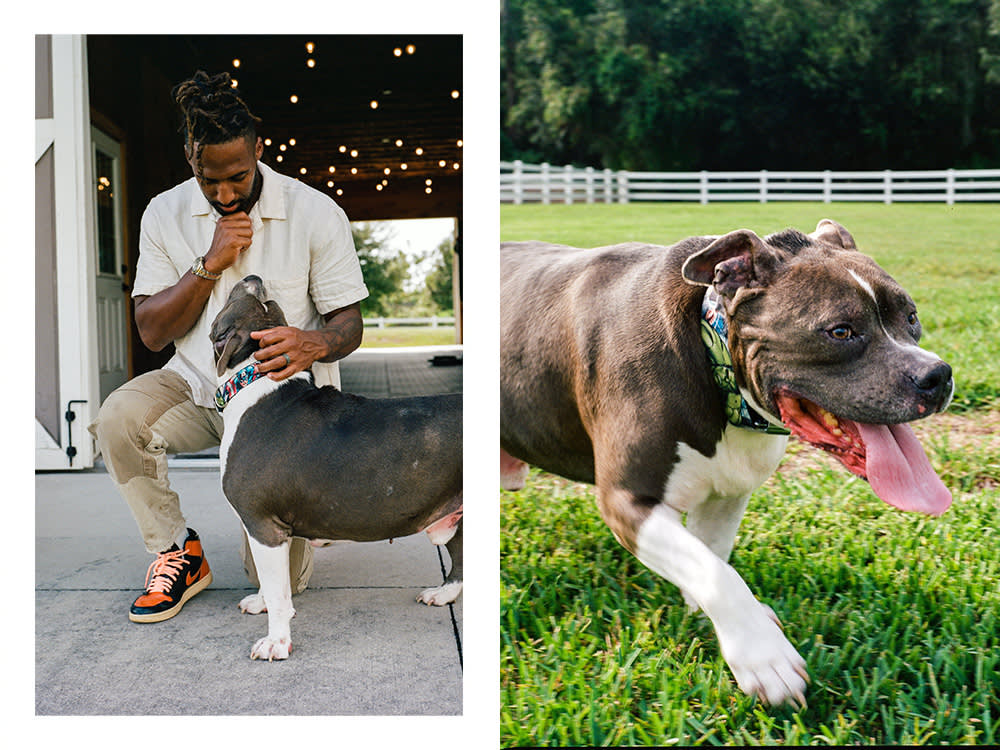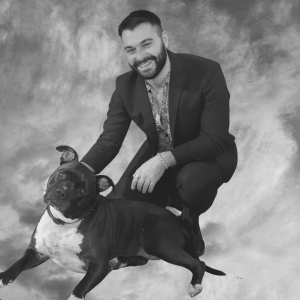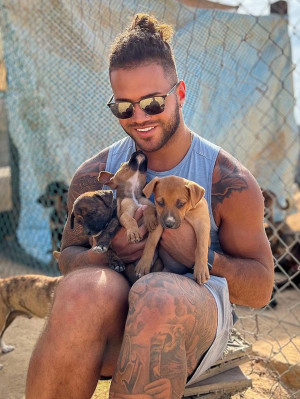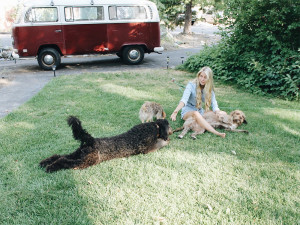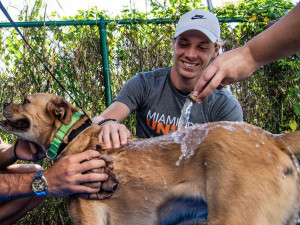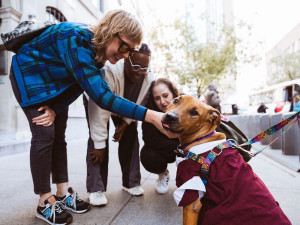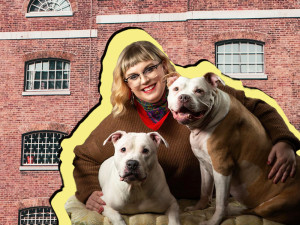The 49ers’ Logan Ryan and His “Water Boy” Pit Bull Are Champions for Animal Rescue
The veteran safety, who’s headed to the Super Bowl this weekend, tells Kinship all about being a dog dad and his org, The Ryan Animal Rescue Foundation.
In many ways, Logan Ryan has already reached career heights that most NFL players only dream of. After being drafted by The New England Patriots, the defensive back won two Super Bowls with the team during his first four seasons — the last of which included the largest comeback in Super Bowl history. Ryan went on to play for The Tennessee Titans, when he famously intercepted Tom Brady’s last throw as a Patriot for a touchdown. Now, after other successful stints with The New York Giants and Tampa Bay Buccaneers, Ryan plays for the San Francisco 49ers — and he’ll be facing off this Sunday against the Kansas City Chiefs in Super Bowl LVIII. But on the field, success has only ever been part of what drives Ryan.
During his rookie season, Ryan and his wife, Ashley, moved to the New England area, where she worked at an animal shelter. On Tuesdays, most NFL players’ only day off during a standard game week, he would visit Ashley for lunch. It was here that Ryan was first introduced to many of the animal welfare issues that plague shelters across the country.
“I saw how tough and grimy it is sweeping up kennels,” Ryan tells Kinship. “She was doing it for the love of it and wasn’t making much money at all. Then, I got kind of attached to the dogs there that weren’t getting adopted.”
So, the young defenseman began using his newfound NFL-boosted social reach to raise awareness about these animals in need of adoption. Every 26th day of the month (the date that corresponded with his jersey number at the time), Ryan began posting a picture of a pet with the hashtag #RyansMonthlyRescueopens in new tab in hopes of helping them find forever homes. After the first 11 months and 11 posts, 11 dogs were adopted. One of them, a Pit Bull named Leo, came home with Ryan. Leo not only introduced Ryan to the specific challenges Pitties face but also reminded him not to judge animals based on the perception of others. It’s a belief that was crucial to both his wedding day and the rescue organization that the event inspired: The Ryan Animal Rescue Foundationopens in new tab (RARF).
How much do you spend on your pet per year?
Following their wedding on the Caribbean Island of Saint Lucia, Ryan and Ashley ventured into town for a photo shoot when they were greeted by roads littered with street dogs. The local photographer initially advised them to ignore the animals but, naturally, they didn’t listen. The couple gave the strays lots of attention during the shoot, and a few pups even made their wayopens in new tab into the wedding picsopens in new tab. What would have likely been a cute wedding story for most stuck with Ryan in a profound way. “We did the photo shoot, went back to our room and something just didn’t sit right. We were like, man, there’s a lot of animals. I wonder how we can help,” Ryan remembers.
First, the couple made a large donation to Helpawsopens in new tab, the only animal shelter in Saint Lucia at the time. Then, they canceled their registry and asked for donations to Helpaws in lieu of traditional gifts. Ultimately, the rescue received tens of thousands of dollars in support from the wedding.
This effort sparked a lingering desire to do more, and the day after they got back from their honeymoon, Ryan and his wife called a lawyer to file RARF as a 501(c)(3) nonprofit. Today, the org partners with shelters and rescues throughout the United States to promote adoption, provide resources for pets in need, and offer education to help combat animal mistreatment. RARF also regularly hosts charitable events to raise funds for those who need them and continues Ryan’s Monthly Rescue by often highlighting entire shelters.
Ryan tells Kinship about the work RARF is doing, Leo’s NFL doppelgänger, lessons learned from playing ball, and how he’s fighting stereotypes across the board.
How has running RARF been different from what you initially imagined?
I’ll tell you what: It is definitely a job. We have employees now; it’s a full-time thing. We had to be mindful of the people that we were gifting the money to and that they were doing the right thing, that they were pricing the spay/neuter [surgeries] right. We focus a lot on pet retention because I can get a dog adopted on my Instagram fairly quickly, but people don’t understand that two weeks later that person might return that dog because their claim to fame is over with. So, we had to focus on how to keep animals, pet owners, and houses together.
There are also very few Black males in the animal rescue world... We offer a lot of opportunities for minorities in the space. I never knew or thought we’d be the face of that. So, these are issues that came up, and we were like, “Yeah, we could talk about the stereotypes of a lot of rappers and Pit Bulls on chains, but I’m fighting to get rid of breed restriction.” We got turned down from 10 different apartment complexes, condos, and renting houses because we had a Pit Bull. And I’m a million-dollar athlete.
You also regularly leverage your status on social media, often posting pictures of dogs in need of adoption. Why is it important to you to use your platform in a positive way like this?
I honestly feel fortunate to have a platform, and I try to speak for the animal volunteers, animal workers, and the animals who don’t have a voice. There are a lot of people who volunteer real time every day to these animals for no recognition, for no brand deals with no platform. There are a lot of people who have to raise money for dogs for surgeries who are in real need with their pets but can’t afford it. People who have to make tough decisions. I’m fortunate to have a platform, so I’m trying to speak up for all the people and all the issues that we all deal with.
You cofounded RARF with your wife, Ashley. Can you speak a bit to the experience of sharing a passion for animal rescue with your partner?
RARF is really symbolic of our marriage. This foundation came a week after we got married. Like anything, it’s not easy. We have two kids. We have rescue animals. We have two dogs. We have foster kittens. It’s a busy household, and I have a pretty busy career. My wife has another company, as well. So, this is what we do at nighttime when you just want to lay in bed and watch TV. We’ll be like “Hey, let’s do some RARF stuff; let’s have a meeting.” We like to think back and think about how blessed we are and how fortunate we are and why we started it. But it really symbolizes our marriage, and we really put our all into it.
And we’re not afraid to shake it up. We’re not afraid to challenge the industry. We’re not afraid to speak for the younger people in the industry and speak for the minorities in the industry. We’re not afraid to speak for Pit Bulls. We’re not afraid to speak up and see what’s wrong and try to change that as best we can.
Speaking of Pit Bulls, how did Leo come into your life?
When my wife started working at the animal shelter, we had another dog that we got in college, a Puggle, a Pug / Beagle mix, named Nala. We had her already, and she just was a terrible puppy. Rebellious dog, still is. But Ashley really felt like we had to practice what we preach, and we really needed to adopt a Pit Bull. I was like “We have an apartment, they’re not going to let a Pit Bull here,” and she was like, “OK, then we’re moving.” We moved into a house and got Leo a week later.
Leo was found in the streets of Boston, and his back legs were really underdeveloped, so he needed hip surgery. We adopted Leo, paid for his hip surgery. And that led to eight other lower body and lower leg surgeries. A lot of money spent on Leo, but he’s the best dog in the world. He’s the face of our foundation. He just needed a second chance and we love him. He’s the best with our kids. He’s honestly the best dog we’ve ever had.
If you had to put his personality in football terms, what position would he play? It sounds like Nala might be more of a diva receiver type. Leo more of a QB leader type?
Leo’s more of a water boy or tight-end, Gronkopens in new tab-type. He’s goofy. Just trying to chill out, snuggle up on the couch, eat his meals and get pets from whoever will give them to him. When both of our kids were born, Leo was always laying by their stroller, laying by them on the couch, always protective. But he’s just a goofy and loyal dog. He wants a good pat and a good walk every day, and he’s happy. He doesn’t need much.
Leo seems to have a strong bond with both of your kids, clearly opposing the common misconception of Pitties not being safe around children. What other stereotypes of the breed type have you seen him disprove?
Leo’s a big Pit Bull. He’s, like, 90 pounds. But he’s always been very gentle and aware. Even when you hand him food, he takes it very gently. Leo’s always been very emotionally aware, too. For instance...we didn’t know it yet, but [my wife] was pregnant with our son, Otto. She goes, “Leo keeps following me around. When I take a shower, he lays right outside the shower. He does not leave me alone. He hasn’t acted like this since I was pregnant with Avery.” And that is what led my wife to get a pregnancy test — because of how Leo was acting.
When those babies were born, he wasn’t protective in a bad way, but he was so concerned around the kids. He’s always been very patient with them and very gentle with them. I swear if our daughter has a bad day, she goes and gives Leo a hug because he’s just a dog that is always there for you.
How do you juggle the demands of being a professional athlete with your level of animal advocacy?
I wish I had that answer for you; I’d bottle it up and sell it. I don’t know, I do the best that I can. I honestly believe that how you do one thing is how you do everything. And I maximize my efforts in football, I maximize my efforts as a father and as a husband and as a son. I wake up at 5 a.m. to work out. It gives me an hour to do something in the morning before the kids wake up. I have very [few] hobbies. I’m trying to get into golf, but I just can’t even do it more than once a month because I don’t get out there enough. My hobbies are my passions, which are business, football, and obviously, animal advocacy.
Leo turned 10 last year. You won the Super Bowl with a 42-year-old Tom Brady, so you obviously understand the power and wisdom that comes with age. What do people get wrong about caring for senior dogs, and what are people missing when they pass over them in shelters?
We actually adopted a blind senior dog named Julius, another one of my wife’s ideas. He was somebody’s pet for nine years, and he was surrendered. He had no eyes — they were sewn shut. He was really struggling in the shelter because he relied on his hearing and his smell, and obviously a lot of the other dogs were always barking, so he was literally ramming his face into the cage because of the discomfort. We had a baby on the way, a two-year-old, and two other dogs, and we adopted Julius.
With seniors, the commitment might not be as long, but they deserve a good back end of their life. He lived three years for us, and he was a great dog. He fit into our pack and he taught us so much about patience, watching how he would navigate the house with no eyes. I called him Roomba at first because he would bump into every corner. Then, he mapped the room out and literally knew where everything was. There’s so much we take for granted when you have a fully healthy dog.
You’ve played in New York, Boston, Tennessee, and Florida, and at each stop you continued your animal advocacy. How do these issues differ from state to state?
They’re consistent in that there’s a need everywhere, but they’re very different. Doing work up in Boston, there’s a huge awareness out there but the shelters are not in great shape. There’s not enough space to have these larger shelters that you find in the South and the money can’t go as far up there. You’re dealing with smaller shelters that are overrun with more animals that don’t have space to even take them in.
In the South, now you’re dealing with some huge dog-breeding issues and dog-fighting rinks. The shelters are larger, and they don’t have the same issue with overcrowding, but they do have issues with education in terms of dog breeding, dog fighting, and how to break up these rings and get the legislation to want to do that. Then New York and New Jersey, you’ll have a problem renting with a Pit Bull.
What’s your end goal with RARF?
My goal for RARF is to stay ever-changing, but I want to be a face in this animal industry. I want to represent the younger people. I want to represent the minorities. I want to represent the husband-wife couples that are doing it together and get rid of all the stereotypes about Pit Bulls that we’ve been talking about.
I tell my team, “Let’s be ’90s Pepsi; let’s not be afraid to shake it up. Let’s not be afraid to be younger, cooler, hipper, and challenge the norms.” I’m just trying to be a voice for all those people in the animal world and let them know that you can look different. You can be the strong, masculine football player, but you can sit there and help foster kittens, too. We’re trying to break down any stereotype about anything in animal welfare.
